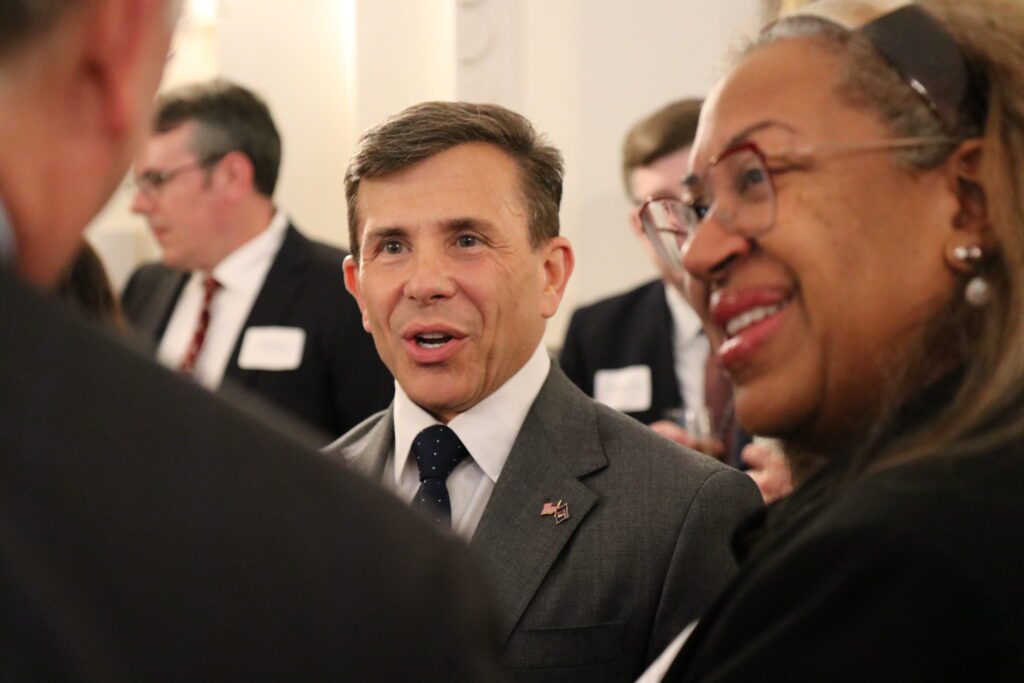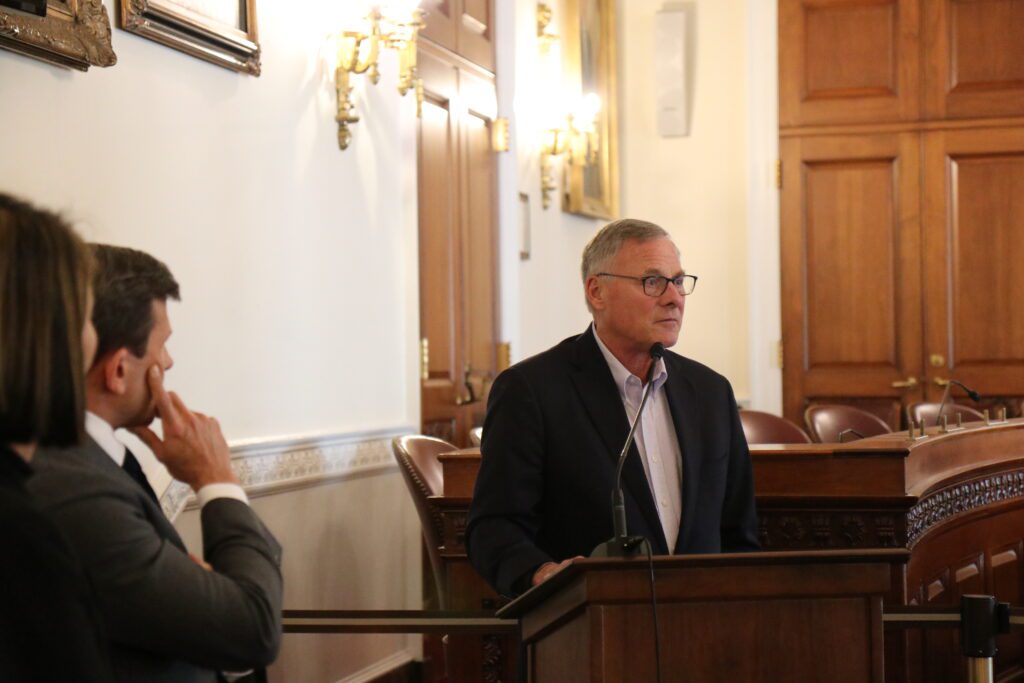2001 was the dawn of the modern era of biosecurity in the United States. Following the 9/11 attacks and deadly anthrax letters, the nation realized its vulnerability to bioterrorism, leading to the 2004 launch of Project BioShield to combat chemical, biological, radiological, and nuclear (CBRN) threats.
As we navigate the aftermath of COVID-19—and mark the 20th anniversary of Project BioShield on July 21—the Biotechnology Innovation Organization (BIO) calls for the reauthorization of the Pandemic and All-Hazards Preparedness Act (PAHPA), born from Project BioShield, to bolster our defenses against the next generation of global health threats.
“This novel public-private partnership program has brought the biotechnology industry together with the U.S. government to improve our country’s readiness for potential chemical, biological, radiological, and nuclear national security threats,” said Phyllis Arthur, BIO’s EVP and Head, Healthcare Policy and Programs, speaking at a May 8 reception on Capitol Hill to mark Project BioShield’s anniversary.
“We must advance biotechnology as a national security imperative,” said BIO President & CEO John F. Crowley at the event, “and we need to do that because it’s important for pandemic preparedness.” In the past 20 years, Project BioShield has played a key role in advancing biosecurity, as well as public health and government-industry partnerships in this realm, he explained—and it’s more important than ever that these important programs continue.

A short history of biosecurity post 9/11
It can be hard to recall what national security, public health, and healthcare innovation were like two decades ago. In fact, prior to COVID-19, many Americans had little knowledge of how healthcare R&D worked, let alone that the mechanisms that allowed for the COVID pandemic to be addressed were put into place in the early 2000s.
“You have to put yourself in the context of the time,” said former Sen. Richard Burr (R-NC), a key architect of the legislation that created Project BioShield, in an interview with Bio.News. “With the convergence of 9/11, the anthrax letter attacks, and the growth in global travel, we were really pointed towards the fact that we needed a different level of security, and we needed a different level of focus on biosecurity.”
Sen. Burr and former Sen. Judd Gregg (R-NH) drafted the legislation that would become the Project BioShield Act, which specified Special Reserve Fund (SRF) funding be directed to support chemical, biological, radiological, and nuclear countermeasures that address material threats, explains BIO’s recent paper, “Twenty Years of Preparedness: Reflecting on the Legacy of The Project BioShield Act of 2004,” published in tandem with the 20th-anniversary event.
Project BioShield has provided multi-year funding and incentives to expedite R&D, procurement, and stockpiling of medical countermeasures like vaccines, therapeutics, and diagnostics—including many in the past 20 years that might not have been developed otherwise.
“By bolstering the nation’s ability to respond to CBRN threats,” writes BIO, “Project BioShield has strengthened national security by mitigating the risks posed by bioterrorism and reducing vulnerabilities to naturally occurring pandemics or outbreaks of infectious diseases.”
The enactment of PAHPA in 2006, with help from the late Sen. Ted Kennedy (D-MA), led to the creation of the role of the Assistant Secretary for Preparedness and Response (ASPR), now the Administration for Strategic Preparedness and Response, as well as the creation of the Biomedical Advanced Research and Development Authority (BARDA). ASPR “constantly scans the horizon to prepare for whatever emergency may come next, whether natural or manmade,” as stated on their website, acting not only as the vanguard for pandemic preparedness from day to day but also overseeing response and recovery.
“PAHPA was the architecture for Project BioShield to happen within the legislative government,” explained Sen. Burr. “Each time we reauthorized PAHPA, we were smart enough to take what we learned over the five-year reauthorization period and incorporate those changes in the next reauthorization.” The key to the success of BioShield and PAHPA is that ability for adaptation, allowing Project BioShield to efficiently realize both its goals of accelerating countermeasure development and enhancing national security.
“Both programs have been really successful,” said Sen. Burr. “BioShield within PAHPA has acted as the roadmap for the government, saying here’s what you need to focus on, here’s what you need to look for, here are the areas, here the tools that we’re providing to you to be a partner with the private sector.”

The legacy of Project BioShield
“As a result of the Project BioShield Act…a diverse and expansive portfolio of 35+ medical countermeasures have been funded, 27 of which have been delivered to the Strategic National Stockpile (SNS) or procured via vendor managed inventory for potential use in the event of a public health emergency,” says the BIO paper.
Some of these successes include:
- Vaccines and therapeutics for treatment of anthrax;
- A treatment for symptomatic botulism;
- Multiple vaccines and a treatment for smallpox (and ultimately Mpox);
- Intranasal nalmefene for opioid overdose;
- Countermeasures and treatments for the effects of radiation exposure and thermal burns;
- Treatments of nerve agent injury; and,
- A vaccine and treatment for prevention of Ebola viruses, among others.
The project exemplifies how government entities, industry, and academia can work together to push innovation into overdrive—and the world benefits.
Importantly, the legislation distinguishes the federal government as a partner to private industry, not the creator of solutions. This dynamic was never more apparent than from 2020-2023.
BioShield in the post-COVID era
“COVID was the biggest success story when it came to proving why PAHPA was so important because the architecture was there to allow necessary innovation to happen,” said Sen. Burr. “In that particular case, policymakers and government officials turned to what was the foundational piece of BioShield,” a mechanism for industry and government to come together and share the risk of R&D.
“BioShield and PAHPA allowed the government to say, we can have a relationship where there was no downside risk to the private sector,” said Sen. Burr.
While we have come out of the other end of the COVID tunnel, a number of threats still need to be addressed, such as Ebola and smallpox. As noted in BIO’s paper, while a vaccine for the Zaire Ebola virus is available, neither the Sudan Ebola virus nor the Marburg virus (which both saw spikes in cases and deaths in 2022-2023) have available vaccines to mitigate them. Similarly, the onset of Mpox in 2022 proved that, even though smallpox has been historically eradicated, the risk of a pox-related epidemic is still a distinct possibility.
The rise of zoological spillover events has led proponents of the legislation to push even harder for its continuation and support. “You hope that no threat presents itself,” said Sen. Burr, “yet you need a threat to compel Congress to act. Right now, that threat is highest in zoological spillover of diseases. We might be closer to that reality than we think.”
As Bio.News reported earlier this year, a Ginkgo Bioworks report found “a 50-50 chance we’ll have another [global pandemic] before the year 2049.”
“Bird flu is probably a great example where the government is going to have to assess whether they were asleep at the helm,” he said. “We’ve had bird flu around for a number of years, and we thought it was limited to poultry. We didn’t think there would be a transmission to cows, and now we’re finding it in porpoises. And my concern is that we’re making the same mistake that we made in COVID.”

The next step is clear: reauthorize PAHPA
As we await PAHPA’s reauthorization, Sen. Burr reminds us that this is not the first time proponents of preventative legislation have had to fight to keep it in play.
BARDA “was on life support three different times because congressional memories are about two years long—they fit in between election cycles,” recalled Sen. Burr. In other words, two years without a scare, and Congress begins to ask questions like, Why do we need BARDA? Why do we need a national stockpile?
But perhaps it should matter in an election year. A recent poll found that 95% of voters believe that “the federal government should prepare for a wide variety of potential public health emergencies.”
“By historical standards, BioShield and PAHPA are pieces of federal legislation that have stood the test of time, and most of it was constructed correctly,” said Sen. Burr. “So far, it has gone through reauthorization in 2013, 2019, and will again hopefully be reauthorized with PAHPA in 2024 or 25.”
As Sen. Burr concluded, the American government’s role is to anticipate and plan for the future, and ultimately, keep Americans safe.
“Our founders set up Congress to be a visionary body,” he said. “We always have to look out of the front window; we can never look out of the rearview mirror. And we’ve got to anticipate where we need to be based upon the threats that are before us and the technologies that we’re capable of creating, as well as that the partnership in the future is really a partnership between government, the private sector, and academia to find solutions to threats that present themselves to not just us but to the globe.”
PAHPA is understood unequivocally to be “must pass” legislation this year. “Project BioShield, and all the great legislation [like PAHPA] that’s come out of it, needs to be renewed to ensure we have more funding going forward, because the threats are now hammering away,” said Crowley. “And in some ways, the need for preparedness is as great—or greater—than ever.”



